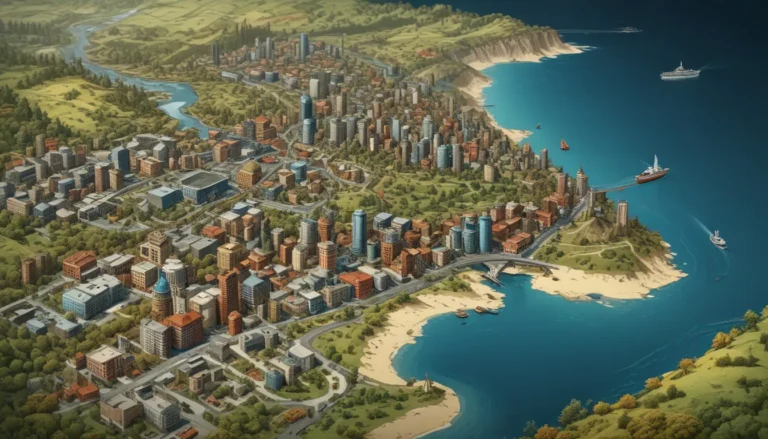A Note About Images: The images used in our articles are for illustration purposes only and may not exactly match the content. They are meant to engage readers, but the text should be relied upon for accurate information.
Have you ever gazed at a topographic map and pondered over the intriguing squiggly lines known as contour lines? These lines are not just random doodles on a map; they serve a crucial role in geography and cartography by depicting the shape and elevation of the Earth’s surface. In this article, we will dive into the fascinating realm of contour lines and unveil some surprising facts about their creation, applications, and significance. So, fasten your seatbelts and prepare to embark on a journey through the captivating world of contour lines!
Unveiling the Secrets of Contour Lines
At first glance, contour lines may appear as simple lines on a map, but they hold a treasure trove of information about the land. These imaginary lines connect points of equal elevation, offering a visual representation of the terrain’s topography. By analyzing contour lines, we can gain valuable insights into the landscape and navigate it with ease.
1. Contour Lines: The Building Blocks of Geography
Contour lines are imaginary lines that connect points of equal elevation on a map or a topographic surface, providing a clear depiction of the land’s shape and form. They serve as the foundation of geographical representations, helping us understand the characteristics of the Earth’s surface.
2. The Rule of Non-Crossing Contour Lines
One fascinating fact about contour lines is that they never intersect on a map. Each contour line represents a specific elevation, and as two different elevations cannot coincide at the same point, contour lines maintain their integrity by never crossing each other.
3. Deciphering Terrain Steepness Through Contour Lines
The spacing between contour lines serves as a key indicator of the terrain’s steepness. When contour lines are closely spaced, it signifies a steep slope, while widely spaced lines indicate a more gradual incline, enabling us to visualize the landscape’s elevation changes more intuitively.
4. Unraveling Unique Patterns: Concentric Circles and “V” Shapes
In regions with elevation changes in all directions, contour lines can form concentric circles, signifying a hill or mountain peak. Additionally, contour lines that create “V” shapes reveal the direction of flowing bodies of water, pointing upstream in valleys and guiding us towards rivers and streams.
The Versatile Applications of Contour Lines
Contour lines are not just aesthetic features on maps; they play a pivotal role in various fields, from agriculture to landscape architecture. Let’s explore how these lines are utilized in different disciplines to enhance understanding and decision-making.
1. Planning Hiking Trails with Precision
Hikers and outdoor enthusiasts often rely on topographic maps featuring contour lines to chart their paths meticulously. By leveraging the information provided by contour lines, they can navigate diverse terrains, assess elevation changes, and choose the optimal routes for their adventures.
2. Shaping Aesthetic Landscapes: The Role of Landscape Architects
Landscape architects harness the power of contour lines to design harmonious and functional outdoor spaces. By interpreting these lines, they can grasp the land’s topography, strategically position design elements, and create visually appealing environments that blend seamlessly with nature.
3. Flood Risk Assessment and Mitigation Strategies
Engineers and urban planners utilize contour lines to assess flood risks in specific areas by analyzing elevation variations. This data informs the development of effective flood control measures and infrastructure to safeguard communities against potential water-related disasters.
4. Cultivating Sustainability: Contour Farming Techniques
In the realm of agriculture, contour lines are instrumental in contour farming, a sustainable practice that involves planting crops along these lines to minimize soil erosion and conserve water. By following the natural contours of the land, farmers can promote soil health and enhance crop productivity.
5. Crafting 3D Models for Diverse Industries
Contour lines serve as essential building blocks in creating accurate 3D models of landscapes and terrains, with applications spanning urban planning, architecture, and even video game development. These models provide valuable insights for various industries, facilitating informed decision-making and design processes.
Decoding the Colorful Language of Contour Lines
On topographic maps, contour lines are often portrayed in distinct colors to enhance readability and comprehension. Each color represents a specific range of elevations, enabling users to quickly discern elevation changes and topographic features with ease.
Unlocking the Mysteries of Contour Lines: Practical Tips and Insights
- Conquer the Terrain: Whether you’re hiking, farming, or designing, contour lines are your trusty guides to understanding and navigating diverse landscapes.
- Enhance Your Skills: Delve into online resources and tutorials to sharpen your ability to read and interpret contour lines effectively.
- Stay Informed: Stay updated on the latest advancements in mapping technologies and contour line applications across various industries.
Conclusion: Embracing the World of Contour Lines
In essence, contour lines are not mere marks on a map; they are intricate symbols that unveil the secrets of the Earth’s surface. By mastering the art of reading contour lines, we can unravel the mysteries of elevation changes, terrain features, and natural landscapes with clarity and precision.
As you embark on your next adventure, whether it’s traversing mountain trails or designing sustainable landscapes, remember the profound significance of contour lines in shaping our understanding of the world around us. Let these lines be your companions in exploration, guiding you through the intricate tapestry of nature’s contours and elevations.
FAQs: Demystifying Contour Lines
-
What are contour lines?
Contour lines are imaginary lines connecting points of equal elevation on a map, portraying the land’s shape and relief. -
How are contour lines created?
Contour lines are generated by surveying the land and measuring elevations at specific intervals to accurately represent the terrain. -
What information can be gleaned from contour lines?
Contour lines offer insights into slope, height, and land features, aiding in identifying various terrain characteristics. -
Can contour lines change over time?
Yes, contour lines can evolve due to natural processes like erosion and tectonic activity, necessitating periodic updates for accuracy. -
How can contour lines be used in navigation?
Contour lines assist in planning routes for hiking, mountaineering, and other activities, enabling effective navigation through diverse terrains. -
What is the significance of contour lines in environmental science?
Contour lines play a vital role in analyzing water flow, drainage patterns, and ecosystem dynamics, aiding in environmental research and conservation efforts.
In conclusion, the world of contour lines is a captivating realm brimming with insights and applications across a multitude of disciplines. By honing our understanding of these lines and embracing their utility, we embark on a journey of discovery and exploration, unraveling the mysteries of our planet’s ever-changing landscapes one contour at a time.






